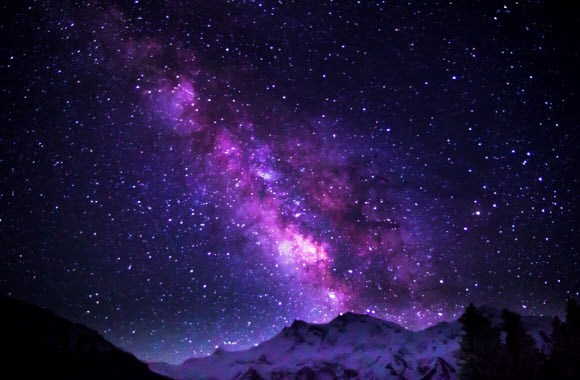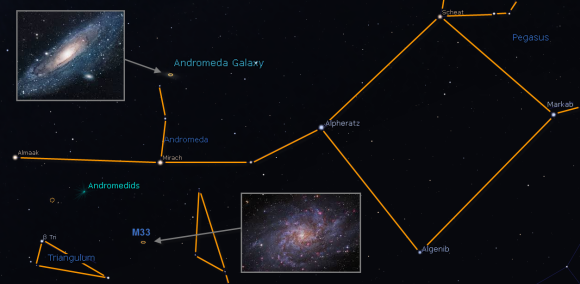
Our view of the Milky Way. (Credit: European Southern Observatory - ESO)
Many amateur astronomers regard September as one of ‘the special’ months in which to explore the night sky. Evening conditions remain conducive for prolonged observation, yet skies are fully dark by 22:00h. During September the summer Milky Way is at its most conspicuous to the naked eye, though sadly for many inhabitants of the UK this magical aspect of the night sky is all too often rendered invisible because of light pollution. Fortunately the North Yorkshire moors and coasts still offer up numerous dark oases from which to fully appreciate our galactic heritage. Choose a moonless period, which in September is at the start or end. Allow a good 15 minutes for your eyes to adapt to the conditions before attempting to trace the path of the Milky Way through the brilliant starry canopy above.
At this time of year, the Milky Way arches up from the NNE horizon, where it flows through Auriga, highlighted by scintillating Capella, dissects the sky overhead, before flowing down through Sagittarius on the SW horizon. In-between these constellations the Milky Way sweeps through Perseus and into the familiar ‘W’ pattern of Cassiopeia, where it is worth while spending some time exploring the star fields and plethora of ‘misty knots’ using a pair of binoculars or small scope. In larger instruments these resolve into glorious star fields and clusters. Moving through Cepheus, the Milky Way then passes overhead, directly through the long axis of Cygnus the swan (also known as the Northern Cross). Here, nearby its chief star; Deneb, the milky stream divides as though passing either side of a long island midstream. Known as the ‘northern rift’, this island is actually a vast intervening dust cloud hundreds of light years in length and some 4000 light years distant that partly obscures the stellar multitude beyond. The two courses continue on down through Aquila, highlighted by the most southerly star of the ‘summer Triangle’, bright Altair, before broadening through Scutum, a small constellation rich in galactic objects. The river spills down over the SW horizon through Sagittarius, an area awash with nebulae, star clusters and dust clouds, hidden within which lies the centre of our galaxy.

The Milky Way viewed from the Mountain of Nanga Parbat ("The Killer Mountain")
in Northern Pakistan. Photo by Pervisha Khan)
Even today the sight of the Milky Way can be magical experience, but for thousands of year’s ancient civilizations across the world revered its presence. To them it represented an overarching divine water course or spiritual path, guiding the soul of the departed into the afterlife. The true nature of this mystical ghostly light has been understood for over a century, a stellar citadel often depicted as a multi-armed spiral structure like a Catherine wheel on bonfire night. However, it is only in the last decade combining data obtained from across the electromagnetic spectrum and from many varied sources that a clearer, more refined picture of our stellar metropolis has emerged.
Our galaxy is now classed as a ‘barred spiral’ some 90 –110 thousand light years in diameter with just two major arms and two lesser ones. The major spiral arm’s, the nearest of which lies 6500 light years away, are around 1500 light years thick. The central bar consists of stars orbiting in highly elliptical paths and is approximately 28,000 light years in length, bulging at the centre by some 12,000.light years. Our own Sun is located on the edge of the ‘Orion spur’, midway between two major arms and regarded as a fairly quite stellar neighbourhood approximately 26,000 light years from galactic centre. At the very heart of our galaxy lurks a black hole that feeds’ on any star straying too close.
There is strong evidence to suggest that like many galaxies, our galaxy has cannibal tendencies, having absorbed several dwarf galaxies over the millennia. Astronomers now believe that some of the many globular clusters visible around the periphery of our galaxy are in fact the central cores of these.
So when you next gaze up in awe at the Milky Way, ponder this. Within our ‘island universe’ the Sun is just one of 200 billion other stars about which orbit over one trillion planets ( estimates continue to rise) Is it unreasonable to suppose that on some of these worlds alien eyes also wonder about the majestic river of light?
The Andromeda Galaxy
Now it’s time to track down an entirely different system. Sound difficult? Well it’s easier than you may think. First find the great square of Pegasus located a couple of hand spans above the east horizon. (see chart) Extending eastwards away from Alpheratz, the square’s upper left hand star, a chain of stars mark the main body of Princess Andromeda. Starting from Alpheratz, count two stars along this chain before turning northwards passing two fainter stars. Close by the second of these look for an elongated misty patch of light; the Andromeda Galaxy.
At a distance of 2.65 million light years our sister galaxy is considered the most remote object visible to the unaided eye. If skies are dark and transparent it should be relatively easy to identify, but if you are not sure use the “averted vision” technique; i.e. don’t look directly at the object, but to one side, utilizing the more sensitive rod cells of the eye allowing faint nebulous objects to stand out.
The Andromeda galaxy, together with our own Milky Way and another spiral galaxy, the Pinwheel galaxy ( marked on chart - M33) are the three ‘big fish’ in a cluster of galaxies known as the ‘local group’ all gravitationally bound together. The others are small irregular galaxies too faint for the average backyard telescope. In an expanding universe where everything is hurtling away from one another, the Milky Way and the Andromeda galaxy are slowly edging together, a process that will take four to five billion years, merging around the time our Sun reaches the end of its life. So, whether you use the naked eye, binoculars or a telescope to view our ‘near’ galactic neighbour, it is astonishing to reflect that this faint smudge of light emanates from over 300 billion suns arranged in a spiral system spanning some 160,000 light years across. The combined radiance diminished only by a 2.65 million year journey, a journey that started when our early human ancestors first gazed up at the starry firmament.
- Log in to post comments


